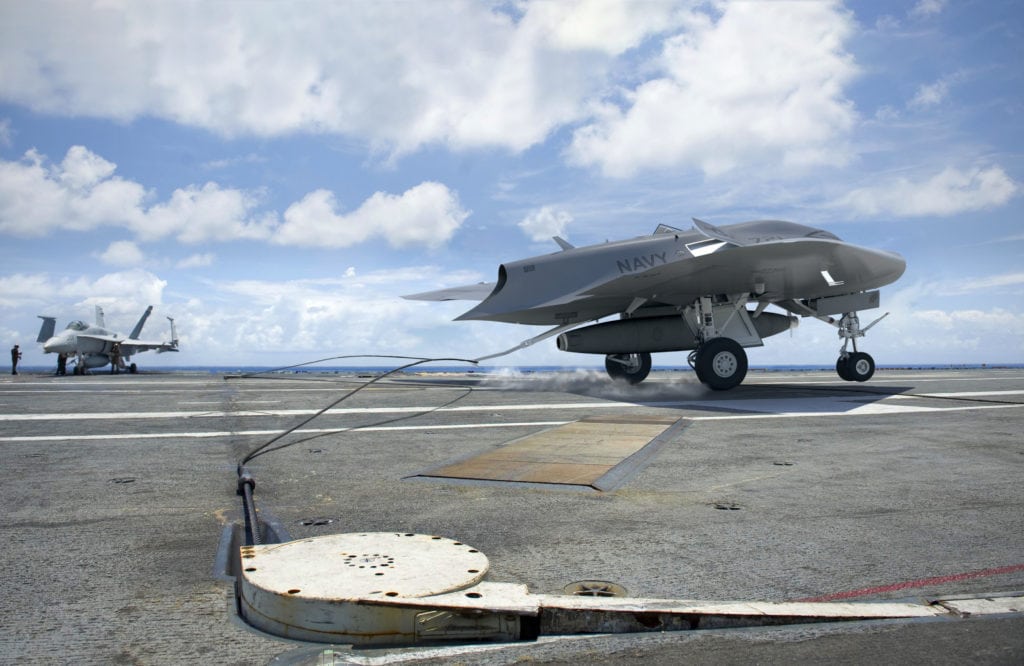
Lockheed Martin’s MQ-25, shown here catching a wire to land on an aircraft carrier, uses the F-35’s landing gear. (Photo courtesy of Lockheed Martin)
Manned and unmanned aircraft working in tandem is the arena where Lockheed Martin sees the upcoming MQ-25A Stingray breaking ground, according to Skunk Works head Rob Weiss.
Speaking at the annual Sea-Air-Space exposition Monday, the soon-to-retire Weiss and his successor, Jeff Babione, formerly of the F-35 program, discussed the unmanned tanker that Lockheed’s advanced developments division is working on for the U.S. Navy.
Weiss stressed the importance of the MQ-25 being purpose-built while most tankers are derivatives of other designs, which, he said, generally leaves them compromised. Originally, Lockheed did look at re-purposing its canceled U-class surveillance drone, the Sea Ghost, but Weiss said that the Skunk Works team was unsatisfied.
The result is a built-from-the-ground-up flying-wing UAS designed to check all the Navy’s boxes for range (Lockheed touts a 52% increase for an F-35C) and carrier-suitability and to leave room for future growth.
That said, the Stingray’s design leverages tech familiar to other Lockheed Martin projects. It uses the same GE-made F404 engine as the F-18. UTC Aerospace Systems provides it with the F-35’s landing gear. Triumph Group’s aerostructures division, which worked on the F-8 Crusader, E-2D Hawkeye, P-8 Poseidon and F-35 Lightning II (among others) is building the internal structure.
Babione said that relying on so much known-quantity technology cuts down on cost and risk of delay or malfunction for the Navy by tapping into existing supply chains and economies of scale with each of these parts.
The trade-off for that reuse is that no capabilities are new, either. But Weiss said they aren’t supposed to be. “The breakthrough that’s going to occur with the MQ-25? It’s not, frankly, operating an unmanned air system off a carrier. We know how to do that, and the design itself is low risk. But the learning and the opportunity is going to be the man-unmanned teaming that comes with it.”

The Stingray’s front-facing sensors come into play in communication with landing crew. (Photo courtesy of Lockheed Martin)
A lot of that ability comes from the AI Lockheed Martin has running the MQ-25. For instance, sensors on the front of the Stingray through which the operator watches a yellow-shirted leading petty officer directing them on a carrier flight deck also has indicators to show the LPO that the operator is watching them. That is to facilitate communication and easier landing and parking on a crowded flight deck being shared by manned and unmanned aircraft.
The company won’t reveal any partners working on internal technology or avionics yet, but Weiss said that Lockheed is leveraging its work on open-system architecture to mission control systems to give the Stingray that ability to work smoothly with manned aircraft, some basic ISR capabilities, multi-vehicle control potential and, above all else, the ability to grow and adapt in the future.
To that end, stealth capabilities are one arena that Weiss said could become relevant at some point. Though the Stingray is not a low-observable stealth design, the flying-wing form factor and open-architecture system lend themselves to that capability if the Navy expresses interest in the future.
A demonstration for the Navy is coming up soon, showing an unrevealed configuration aircraft that Skunk Works is confident “is very representative” of the MQ-25’s capabilities.